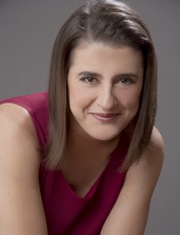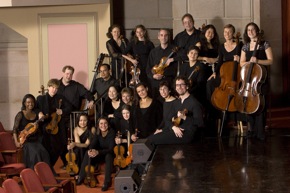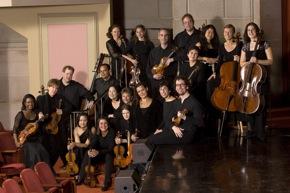
Anyone who might have arrived very late for Saturday’s splendid New Century Chamber Orchestra concert at Herbst Theatre would have gotten an amusing summary from fiddler Evan Price. Riffing through a sustained and witty improvisation in Aaron Copland’s Hoe-Down, from the Rodeo ballet score, Price stood in the back row and quoted both works from the first half of the program — Samuel Barber’s Adagio for Strings and Copland’s Appalachian Spring — along with Turkey in the Straw, Eine Kleine Nachtmusik. and assorted other bits and scraps.
What Price couldn’t possibly invoke in telegraphic form was the new William Bolcom violin concerto that served as the substantial centerpiece of this all-American evening. Commissioned by NCCO and composed specifically for Music Director Nadja Salereno-Sonnenberg as its soloist, this three-movement Romanza for violin and string orchestra proved to be an altogether engaging world premiere. Brimming over with passion and brio and a vivid interplay of the solo and orchestral voices, the piece unfolded in a sequence of sharply contrasting but dramatically integrated moods.

At once intimate and expansive, the opening movement employed a tiny stuttering figure for the soloist as its animating force. Infusing the material with a blend of forcefulness and easy generosity, Salerno-Sonnenberg kept raising suggestions, by turns jaunty, jittery, and somber, and handing them over to the orchestra for development. Then she’d take them back, transformed, and move the musical discussion onto a new plane. The listener had the sense of there being progressively more and more at stake. At the peak, the orchestra seemed to melt down, with chords collapsing in on themselves. The soloist pressed on with somber dignity and a final joyous exclamation.
Then, as if to vanquish all that eventful clamor, a funeral march followed. Against a chromatic dirge that came in tidal waves of orchestral pressure and release, the soloist offered a barbed, two-note pattern. That led to a passage of bleak gaiety, giving way to a death-spiral cadenza. Just when things looked their darkest, with more of those self-destructive chords, a wonderfully clomping cakewalk broke out to bring this piece to an infectiously jolly conclusion. You could almost feel the audience grinning along.
Salerno-Sonnenberg gave a spirited and subtly cadenced performance. Her playing was assertive, full of character, deferential when necessary, and always attuned to the overall effect. The ensemble seemed every bit as responsive and committed to this fine new work as its leader. A microphone stand placed directly in front of the soloist added the one unseemly and distracting element.
While the rest of the program was devoted to familiar repertoire, the orchestra gave it all an air of freshness and discovery. At once delicate and direct, their account of the Barber Adagio eschewed the customary keening and sobbing; what came through, despite a little screeching at the climax, was genuine feeling rather than melodrama. As for the Copland, their “chamberized” Appalachian Spring suite (scored for 13 instruments) balanced driving energy and a blossoming, innocent tenderness. The three woodwind players made fine contributions, none better than those of clarinetist Jerry Simas, whose every phrase seemed sweetly scented.
In the program-ending Hoe-Down, Salerno-Sonnenberg and company seemed to pick up right where they’d left off in the Bolcom cakewalk. They just hadn’t had quite enough raw-boned fun yet, apparently. All the players, the delightfully long-winded Price very much included, leaned into Copland’s jubilant dance with a glittering, decisive, and single-minded brightness.

